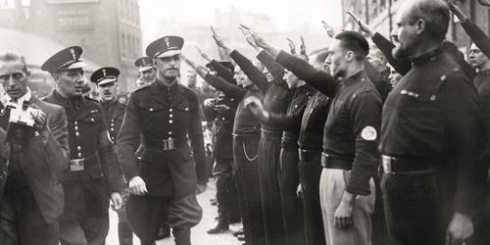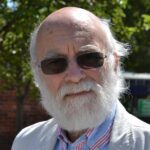The following article by Colin Shindler appeared in The JC on 29 September 2016.

Oswald Mosley instituted antisemitism as the official policy of the British Union of Fascists only in 1934, some two years after its formation.
The annual report of the Board of Deputies for 1932 stated that Mosley had informed the Board that antisemitism formed “no part of the BUF’s policy”. Yet at a BUF meeting a few months before, he responded to hecklers by telling them they should “go back to Jerusalem”.
Such a slip was indicative of the latent antisemitism of the British upper-class. Mosley, like Churchill in February 1920, said he only detested “international Jews”- meaning Communist Jews.
Indeed in his previous incarnation as leader of the short-lived New Party, Mosley counted the Jewish boxer, Ted “Kid” Lewis as a supporter.
Mosley’s fascism was modelled on Mussolini’s movement which numbered numerous Jews among its founding fathers. In 1932 the Jewish businessman Guido Jung became Italian Minister of Finance. While Mussolini made occasional negative comments about Jews, antisemitic policies were only formally adopted in 1938.
Mosley’s drift from anti-communism towards an overt antisemitism – arose out of a decreasing BUF membership and a desire to find a vehicle for a political breakthrough at a time of austerity and hardship.
In 1936 unemployment in Stepney in London’s East End was 50 per cent higher than in London as a whole. He was egged on by his closest lieutenants.William Joyce, who later as “Lord Haw-Haw” broadcast from Nazi Germany during the Second World War, recommended Mein Kampf to BUF as a text for their speakers in 1934.

Mosley projected himself as a strong, committed leader and a patriot who would cure Britain of all its ills brought on by the cancer of democracy. Another supporter, the writer, AK Chesterton, described him in quasi-religious terms, as “a transcendental figure”.
The BUF march through the East End in October 1936 was designed to expand its pockets of white working-class support. It promoted the fear of the other – the Jews, the Irish, the Communists.
Starting off from Royal Mint Street, near Tower Hill, the Blackshirts were organised into four columns, representing the four years of the BUF. At its conclusion of the march, there would be four public rallies in Bow, Shoreditch, Limehouse and Bethnal Green.
Despite the admonitions by official Jewish bodies, the Jewish press and the Liberal and Labour parties to ignore the provocation, the fascists and their police protectors were met in Cable Street by tens of thousands of Jewish Eastenders and Irish dockers from Wapping.
While the Jews and the Irish did not often wander into each other’s areas, there had been co-operation between Jewish tailors and Irish dockers during the long strikes of 1912. Hundreds of Irish children had been taken into Jewish homes and cared for. In 1936, they returned to pay back that debt.
Barricades were set up, trucks were overturned while a tram, abandoned by its communist driver, proved a major obstacle. Youngsters hurled marbles under police horses’ hooves while housewives poured every sort of rubbish from above onto the heads of the policemen below.
This was almost unprecedented in British political history – and testified to the radicalism of the Jews who carried with them the memories of persecution in Russia and Eastern Europe.
“They shall not pass,” the borrowed slogan of the anti-Franco forces in Spain, invoked Jewish history in its meaning.
As history records, the police commissioner, Sir Philip Games, realised that a stalemate prevailed and instructed the police and the marchers to pull back.
The communists and the Independent Labour Party were instrumental in organising the Cable Street crowds. Many Jews were members of the Communist Party – in their eyes it was both a university for intelligent debate and a means of fighting oppression in the crumbling world of the 1930s.
Yet the London communists had been reluctant to protest against the march since they were keen on cultivating Labour to form a popular front. They wanted instead to settle for a demonstration in support of the Spanish republic in Trafalgar Square. Only at the last minute did they agree to join the local organisers in the East End.
Despite the euphoria in the aftermath, the BUF’s planned four meetings did take place. Mosely continued to make speeches to large crowds, BUF membership increased dramatically while its local election results hovered at around 20 per cent in 1937.
But the symbolism of the BUF’s defeat has proved to be more enduring down the decades than its political effect in 1936.
Sunday October 4, 1936, the day of the Battle of Cable Street, was also the fast of Gedaliah. The killing of Nebuchadnezzar’s representative, Gedaliah ben Ahiham, by Yishmael ben Netanyiah had always been frowned upon by religious tradition. It demonstrated disloyalty to the ruling power. It created hostility towards Jews. It publicly displayed Jewish disunity.
The Jews of the East End on that October day rebelled against this mindset.
It remains a profound example of how to act in dark times.
Colin Shindler is an emeritus professor at SOAS, University of London





